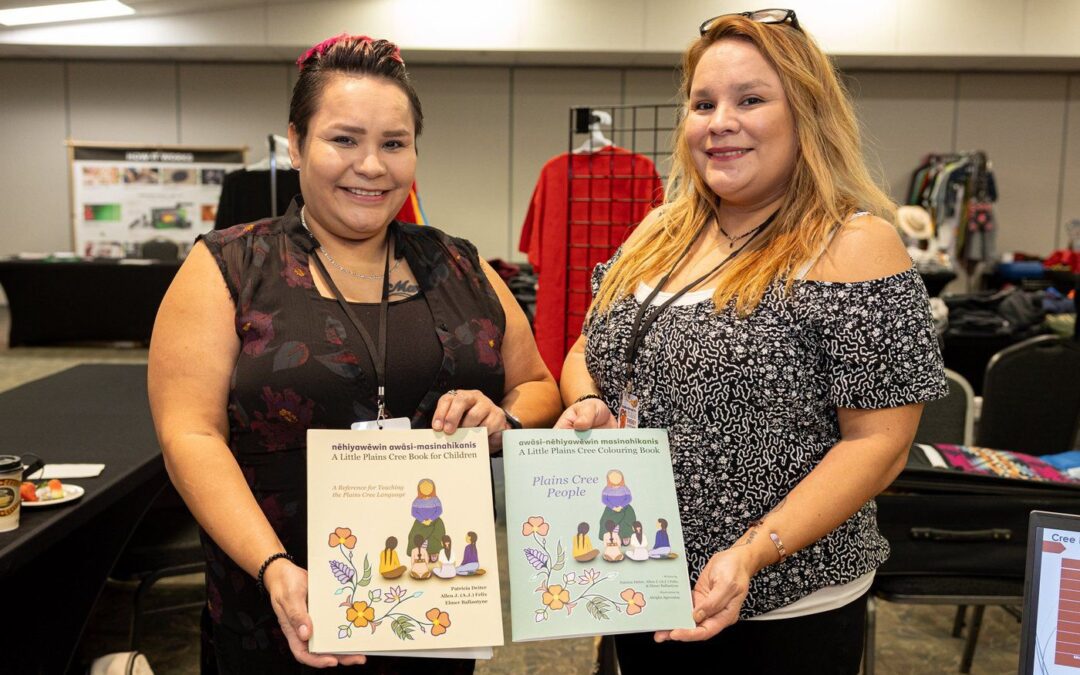1116 News Cree Language – Mary Jane Felix and Elizabeth Felix run the Four Spirits Plains Cree Language Training booth during the Braiding Knowledge for a Clean Future conference at Prairieland Park. (Michelle Berg / Saskatoon StarPhoenix)
By: Kimiya Shokoohi, The StarPhoenix
Throughout history, verbal and visual storytelling have been used to share knowledge and sustain Indigenous culture.One elder is taking it a step further, putting culture and identity down in writing.
Felix, a residential school survivor and national Turtle Lodge Elder, was a part of a lineup of presenters at a climate change conference held at World Trade Center Saskatoon earlier this week.
“Our language was taken away from us. Our spirituality was taken away from us,” Felix said. “These are the gift our families gave to us.”
Felix gave a presentation, “The Issue with Tissue,” on clearcutting and forest destruction. His twin daughters Elizabeth and Mary Jane were there to see it. In their family, love has been the answer to countering a cultural history of trauma; now, they are actively working to repair the pieces of their culture lost amid colonialism, he said.
The twins managed a booth at the conference, selling Cree language literature, ranging from textbooks to colour books and a USB with visual and audio guidance for pronunciations. It’s a part of their efforts to save the language.
The family is in the process of having conversations with schools in northern Saskatchewan to bring resources for learning the native language back into practice.
“I encourage our people to get our language back,” AJ said. “It was a gift that was not given to us by universities or some dictionary; it was a gift that was given to us from the spirt world. If we let it go, we are wrong.”
The Saskatchewan government is recognizing international education in Saskatchewan this week, noting more than 11,000 international students from 147 countries studied in the province in 2022 and 2023, a 120 per cent increase over the past decade.
Grassroots Indigenous education is worth noting alongside those numbers. Select public schools provide Indigenous language offerings, such as St. Frances Cree Bilingual School in Saskatoon.
The University of Saskatchewan has made gains in increasing Indigenous programs and academic avenues. In October, the College of Medicine announced a department of Indigenous Health, and the Department of Indigenous Studies celebrated its 40th anniversary in September.
Indigenous culture and language have traditionally fostered appreciation and understanding of natural lands. AJ is calling for cultural preservation, namely among communities known to be observers of the land and the changing climate.
“Their family was the rock, the trees, the sun, the moon. Their family was the water and the thunder that they heard, and the wind. That’s their family,” AJ said.
Elizabeth and Mary Jane said their parents’ commitment to teaching and protecting their language reflects their love for their culture, community and family, noting the affection and care of they received from their parents as they grew up.
As efforts to better protect the climate have increased, so has recognition of Indigenous knowledge keepers, and their stories and observations of the land.
“The trauma they went through, they went through cultural healing and spiritual healing when they got out (of residential school),” Elizabeth said.
“What the residential schools did is made them distinct against their own kids,” Mary Jane said. “Our family is really close because of our parents. We gather all of the time.”
